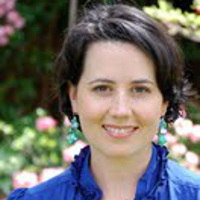Subtitle: Turning Nothing into Something
Every year, I try to transform more of my property from unproductive Bermuda grass to productive fruits and veggies. This year, I want to transform the desolate, wind-swept, 7 x 40 grass strip between our driveways (mine and my neighbors) into a luscious food forest. I am working with Randy Marks, a renowned local Permaculture and LEED certified landscaping expert, to complete the design. How I wish he had lived here four years ago so that I could have consulted with him then!
Currently, the design includes an existing one-year old persimmon tree, adding two pear trees (probably European but possibly Asian), cooking and medicinal herbs like thyme and lavender, edible daylilies, and three of what I’m calling “crop circles.” As there is no faucet near the area, we plan to direct an existing downspout from my gutters into a swale-like streambed in order to water the plants (in addition to hand-watering). The pear trees will cast shade onto my driveway in the afternoon, reducing the glare and heat island effect of the concrete.
My “crop circles” are simply small circular raised beds – around 2-3 feet in diameter – that are designed to hold melons, zuchinni, pumpkins, or winter squash. Because these plants tend to ramble, I will only have to maintain a small, intensely managed planting area (the crop circle) and just let the vines wander on top of the wood mulch in between the pear trees. Since pear trees don’t bear until late, I think I will have harvested most of the melons by the time the pears are ready to pick.
By planting these crops in this area, I won’t have to take up valuable bed space in my back garden or build vertical structures to train them on. If you want to integrate some sort of raised bed for annual vegetables in with the perennials, evergreens, shrubs, and trees in your front yard, these crop circles might do the trick. I’ll let you know how they work out.
An edible landscape may also serve as a demonstration for my neighbors – showing them that growing food and herbs can be attractive as well as functional. Lavender and day lilies are pretty plants, and personally, I like big melon flowers. Since the crop circles are small, there won’t be a lot of bare dirt in the winter when the annuals are gone. And because thyme is evergreen, there will always be a nice green accent to the area, even in the winter (preferable to yellowish brown Bermuda!).
I hope to implement this plan via a Permablitz. A Permablitz is a kind of garden barn-raising. In our case, I want to offer a day-long, hands-on workshop that allows participants to simultaneously learn the concepts of permaculture, such as water use (ex: swales, storage), forest gardening, attracting beneficial insects, and so on; while also actually creating the design (seeing how the concepts are executed in practice). I’m intensely curious to see a swale created. Luckily Randy has volunteered to guide the permablitz – I am excited to learn from his expertise!
Ideally, this project would expand virally into some sort of network where people work on several blitzes, and then are able to submit their own permaculture plan to the group and have the group work on their project. Many hands make light work – and a lot more fun. Plus, participants would then be able to draw on the knowledge, creativity, and resources of the whole group. Or, perhaps someone will take up the idea of permablitz workshops and offer them regularly.
I’ve asked
Sustainable OKC and
Transition Town OKC to sponsor the project. I’ll be purchasing the plants and materials; Randy will be providing the education, and I hope that Sustainable OKC / TTOKC will help with promotion, taking registrations, and providing a videographer. Since the Permablitz will be pretty limited in space, we’ll probably limit the class size to 8 or 10 people. So far, interest seems high – the blitz may fill up fast. I also hope that we can make a short documentary out of the project and post it online.
I’m terribly excited! I’ve wanted to transform that area for years, and this seems an opportune time. I purchased way more watermelon/squash varieties than my back garden can hold – Desert King and Orangeglo watermelons, a Chanterais melon, and Butternut and Black Futsu squashes. I need somewhere to put them all. Can’t wait till April!






